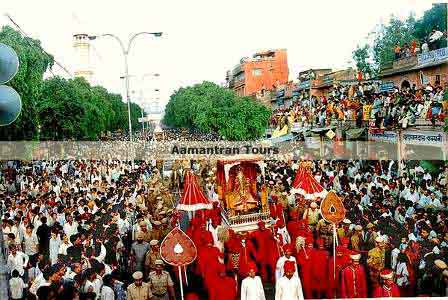 |

|
 |

|
|
|
 This swing festival welcomes the advent of the monsoon. Swings are hung from trees and decorated with flowers. Women, colourfully attired, swing on them and sing songs in celebration. With every drop of first rains; Peacocks dance in ecstasy, spirits soar high in celebration. Song & dance mark the gaiety of the Teej Festival. Teej is held on Third day of the moonlight fortnight of the Hindu Month of Shravan (Mid-July to Mid-August) and marks the advent of the monsoons. The monsoon rains fall on the parched land and the pleasing scent of the wet soil rises into the air. The monsoon rains fall on the parched land and the pleasing scent of the wet soil rises into the air. Teej is the festival
for the daughters of the house. This festival is dedicated to the Goddess
Parvati, commemorating her union with Lord Shiva. The festival is also
dedicated to Goddess Parvati and commemorates the day when she was united
with Lord Shiva after a penance of a hundred years Ė making them a symbol
of an ideal marriage. It is believed that invocation of Parvatiís blessings
on this day results in continued marital bliss.
Type of Teej
On Haryali Teej: The moon
is prayed to.
|
 |
| LEGEND
The legend behind the celebrations is Goddess Parvatiís hard-core Tapasya, before her union with Lord Shiva, for which she took 108 births on the Earth. The Myth goes that she failed to have Lord Shiva as her Life Partner till 107th Birth. But this divine union happened, when she again took birth for 108th time. RITUALS
Women undergo fasts; sing folk songs and dance in the name of Goddess Parvati. It is a belief that unmarried women fasting will luckily find a suitable husband. Fasting married women will also find their husband more faithful and bonds of love strengthened. The images of Parvati or Teej Mata are bedecked in new clothes and jewellery and worshipped. The Teej idol is covered with a canopy whereas the Gangaur idol is open. After a ceremonial worship at home, elephants are taken out in a ceremonial process escorted by camels, and horses. Then the images are taken out in ceremonial processions escorted by caparisoned elephants, camels and horse drawn chariots, as the bride Parvati leaves her parents home for her husband's. The festivity revolves around singing and dancing in praise of Parvati. The devotees surges to catch a glimpse of the deity and seek blessings.
Girls with Henna on
their hands and feet run about joyously and are excused from household
chores on this day. Special Mehndi motifs also called laheria and ghewar
are applied to match the mood of Teej.
Swings are hung from trees and decorated with flowers. Young girls and women colourfully attired, swing on them and sing songs in praise of the goddess and the monsoon. The gracefully ornamented and colourfully dressed women celebrate the day adding fun and frolic to it through their local gatherings. The hands crafted with Henna add into the beauty of the ladies and a popular belief that goes with it is that the darker the Henna the more a man loves his woman. The colours of the month
of Sawan, lilting songs - specific to the festival, are sung to accompany
the application of henna, creating an aura of romance. This atmosphere
of Teej is celebrated with the fullest of life to make it the most memorable
day of the year and for the reason it is the much awaited festival amongst
the girls of India.
The rituals allow one to pamper and enjoy themselves, to fast and feast, to dress the best with best of cloths, finery and jewellery. The festivities end with exchange of gifts and the arrivals of husbands to fetch their wives. The wives then leave then leave their parentís home like Parvati. |